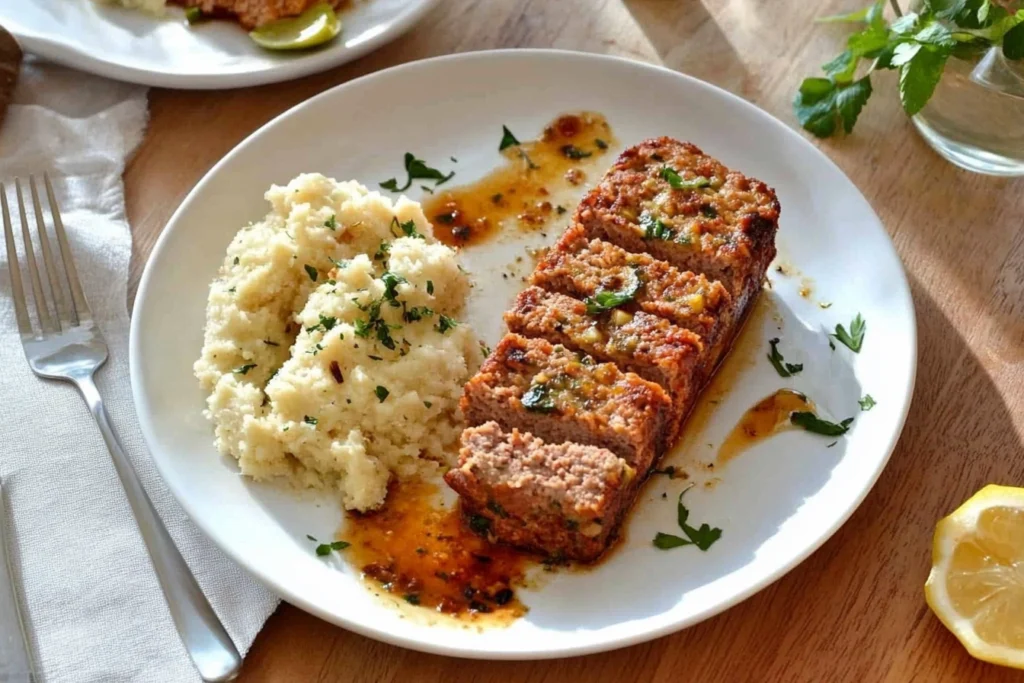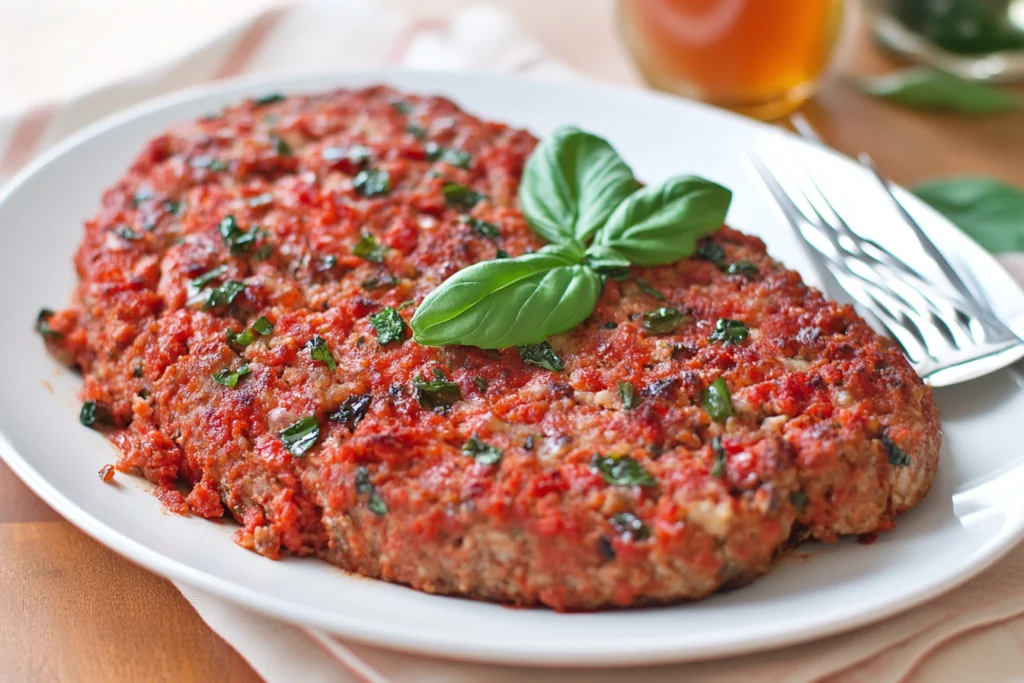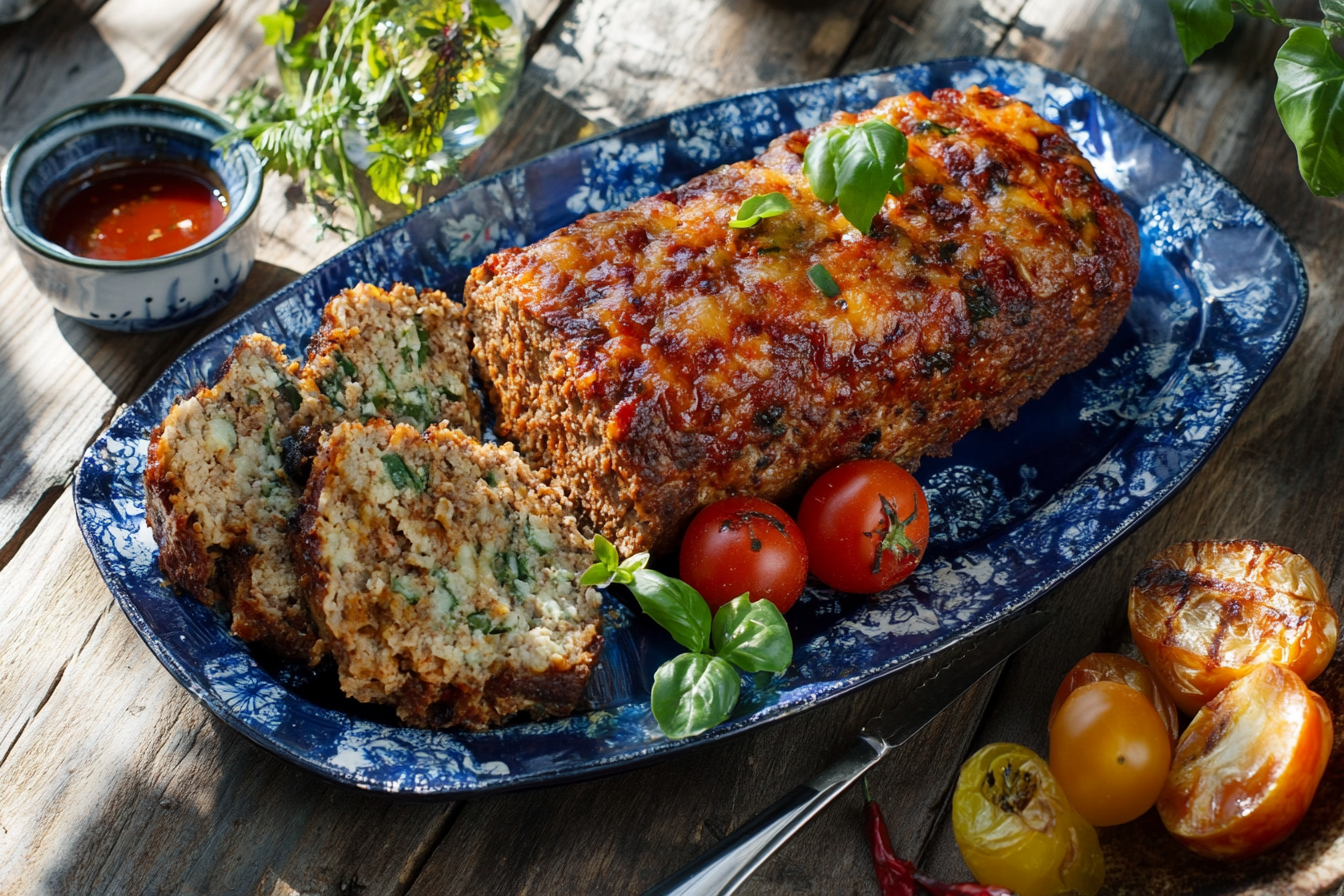Introduction to Moist Meatloaf
Moist Meatloaf has long been a beloved comfort food, gracing dinner tables around the world with its hearty texture and rich flavors. However, the secret to a truly perfect meatloaf lies in its moisture. A moist meatloaf is the difference between a meal that satisfies and one that is memorable.
Why Moisture is Key to a Perfect Meatloaf
Achieving the ideal balance between texture and flavor is a culinary art. When meatloaf is too dry, it can be crumbly, bland, and hard to chew. On the other hand, a meatloaf that’s overly moist risks being mushy and losing its structural integrity. The trick lies in mastering the balance between the two extremes.
Understanding the Texture and Flavor Balance
- A moist meatloaf isn’t just about softness; it’s also about infusing flavor throughout the dish. The moisture allows the meat to absorb seasonings, while keeping the final product tender.
- A well-balanced meatloaf should hold its shape when sliced yet still remain juicy with every bite.
Common Pitfalls of Dry Meatloaf

- Overcooking is the most common reason for dry meatloaf. Exposing the meat to high heat for too long robs it of its natural juices.
- Neglecting the right combination of fats, binders, and liquids results in a crumbly, dry texture.
- Skimping on the glaze or skipping a resting period can also compromise the final dish.
Historical Perspective on Meatloaf Recipes
To understand the evolution of moist meatloaf, it’s fascinating to look back at its history.
How Meatloaf Became a Household Favorite
Meatloaf originated as a frugal way to stretch meat during lean times. In the late 19th and early 20th centuries, resourceful cooks blended ground meat with fillers like bread or grains to make meals more substantial. Over time, families added their own spins, creating recipes that became culinary traditions.
Regional Variations in Texture and Moisture Preferences
Different regions have unique takes on meatloaf:
- In America’s Midwest, meatloaf recipes are often rich and hearty, with an emphasis on butter and eggs for added moisture.
- Southern versions might include a tomato-based glaze that locks in juices, while some European adaptations rely on fatty cuts of turkey to ensure tenderness.
Overview of Essential Ingredients
Moist meatloaf starts with the right ingredients. Every element in the recipe serves a purpose in creating that perfectly tender result.
Balancing Fats, Binders, and Proteins
- Fats are critical for juiciness. Ground meats with at least 20% fat content are ideal.
- Binders like breadcrumbs and eggs prevent the loaf from falling apart while maintaining softness.
- Proteins such as beef, or turkey provide the dish’s base and texture.
Ingredient Combinations for Enhanced Moisture
- Combining different meats ,creates a balanced flavor profile and ensures a richer texture.
- Adding moisture-rich vegetables, dairy products, and even broth can elevate a simple meatloaf recipe into something extraordinary.
Key Ingredients for Moisture in Meatloaf
Creating the ideal texture relies on more than just cooking techniques. The choice of ingredients plays a pivotal role in retaining moisture throughout the cooking process.
Role of Fatty Meats in Retaining Juiciness
Meatloaf’s primary ingredient is ground meat, and the fat content determines much of its texture.
Choosing the Right Meat-to-Fat Ratio
- A blend of 80/20 ground beef (80% lean, 20% fat) is optimal for meatloaf.
- Leaner meats, like turkey or chicken, benefit from added fats to prevent dryness.
Mixing Ground Beef,and Veal for Optimal Texture
- Combining different meats ensures a well-rounded flavor and texture. turkey adds moisture, veal offers tenderness, and beef provides structure..
Binders That Keep Meatloaf Moist
Binders are essential in ensuring that the meat mixture holds together while adding moisture.
Using Breadcrumbs, Oatmeal, or Crackers Effectively
- Soak breadcrumbs or oatmeal in milk before mixing them into the meat. This simple step prevents the loaf from becoming dense or dry.
- Crushed crackers add a touch of texture while absorbing excess liquid.
Eggs as a Moisture Enhancer and Binder
- Eggs not only bind the ingredients but also provide richness and moisture.
- Use at least one egg per pound of meat for best results.
Liquid Additions for Extra Moisture
Liquids play a dual role in softening the binders and infusing flavor throughout the meatloaf.
Milk or Cream as a Softening Agent for Binders
- Soaking breadcrumbs in milk or cream results in a softer, more tender texture.
- For a richer taste, opt for heavy cream instead of milk.
Other Liquids Like Broth, Tomato Sauce, or Worcestershire Sauce
- Chicken or beef broth adds depth and keeps the meat mixture moist during baking.
- Tomato-based liquids, such as canned tomato sauce or ketchup, provide tangy, moisture-rich flavor.
- Worcestershire sauce lends an umami boost and enhances the overall taste profile.
Vegetables for Natural Moisture and Flavor
Vegetables are a fantastic way to add both flavor and moisture.
Adding Grated Onions, Carrots, or Zucchini
- Grated onions release juices that soak into the meat, preventing it from drying out.
- Carrots and zucchini bring a subtle sweetness and keep the loaf tender.
Sautéing Vegetables for Enhanced Moisture Release
- Cooking vegetables like onions, garlic, or celery before adding them to the mixture ensures they release their moisture evenly during baking.
- Sautéed veggies also contribute a layer of caramelized flavor.
The Secret to Moist Meatloaf: Part 2

Key Ingredients for Moisture in Meatloaf
Role of Fatty Meats in Retaining Juiciness
The foundation of any great meatloaf starts with selecting the right combination of meats. Fatty meats not only bring flavor but are also key to ensuring that the loaf remains moist.
Choosing the Right Meat-to-Fat Ratio
- When choosing ground beef, go for an 80/20 ratio. Too much fat can cause the loaf to fall apart, while too little fat leads to dryness.
- If you prefer leaner meats like turkey or chicken, consider mixing in a bit of olive oil or butter to compensate for the lack of natural fat.
Mixing Ground Beef, and Veal for Optimal Texture
- Using multiple types of ground meat is a classic trick for keeping meatloaf moist. turkey is naturally rich in fat, veal adds tenderness, and beef contributes robust flavor.
- Blend the meats thoroughly but avoid overmixing, which can make the final loaf dense.
Binders That Keep Meatloaf Moist
Binders play a critical role in keeping the meat mixture together while locking in essential moisture.
Using Breadcrumbs, Oatmeal, or Crackers Effectively
- Breadcrumbs act as sponges, soaking up liquid from milk, broth, or eggs and releasing it slowly as the meatloaf cooks.
- Oatmeal is an excellent gluten-free option that provides a hearty texture while absorbing moisture.
- For added flavor, consider crushed crackers or panko breadcrumbs, which bring a subtle crunch without drying out the loaf.
Eggs as a Moisture Enhancer and Binder
- Eggs serve as a natural emulsifier, binding the fats, liquids, and proteins into a cohesive mixture.
- Use one egg per pound of meat for best results. If you want extra creaminess, mix an additional yolk into the blend.
Liquid Additions for Extra Moisture
Liquids are crucial for achieving a tender meatloaf. They not only soften the binders but also keep the mixture pliable and flavorful.
Milk or Cream as a Softening Agent
- Milk softens breadcrumbs and ensures the loaf stays moist during baking.
- For a richer taste, substitute heavy cream or half-and-half for milk. This small tweak can make a noticeable difference in both flavor and texture.
Other Liquids Like Broth, Tomato Sauce, or Worcestershire Sauce
- Adding beef or chicken broth to the mixture prevents the meat from drying out as it cooks.
- Tomato-based liquids such as ketchup, tomato paste, or canned tomatoes introduce tanginess and balance the flavors.
- Worcestershire sauce is an excellent source of umami, enhancing the savory profile of the dish.
Vegetables for Natural Moisture and Flavor
Vegetables do double duty in a meatloaf recipe. They provide natural juices and elevate the dish with layers of flavor.
Adding Grated Onions, Carrots, or Zucchini
- Grated onions are a must for a moist meatloaf. Their juices seep into the meat, distributing moisture evenly.
- Carrots and zucchini are equally effective. They contribute natural sweetness while preventing the loaf from becoming dry.
- Always finely grate the vegetables to ensure they integrate smoothly with the meat mixture.
Sautéing Vegetables for Enhanced Moisture Release
- Sautéed vegetables release their juices before being added to the mixture, ensuring the flavors meld perfectly.
- Ingredients like garlic, celery, and bell peppers benefit from being cooked in butter or olive oil first. This step boosts flavor while contributing extra moisture.
Cooking Techniques for a Moist Meatloaf
While ingredients play a vital role, the way you cook your meatloaf can make or break its texture. Proper techniques will ensure your loaf is moist, tender, and delicious.
Temperature and Cooking Time
Low and slow is the mantra for cooking a moist meatloaf.
Why Low and Slow Cooking is Essential
- Cooking at a lower temperature, such as 325–350°F (160–175°C), ensures the meat cooks evenly and retains its juices.
- High heat risks overcooking the outer layers before the center is fully cooked.
Avoiding Overcooking and Internal Temperature Guidelines
- Use a meat thermometer to avoid overcooking. The ideal internal temperature for meatloaf is 160°F (71°C).
- Remove the meatloaf from the oven when it’s 5°F below the target temperature, as it will continue to cook while resting.
Using a Loaf Pan vs. Freeform Baking
The method you use to shape and bake your meatloaf impacts its final texture.
Pros and Cons of Each Method
- Loaf Pan: Keeps the shape uniform and ensures the meatloaf cooks evenly. However, it can trap excess grease if not drained properly.
- Freeform: Baking on a sheet pan allows fat to drain away, creating a slightly firmer texture.
Techniques to Prevent Soggy or Dry Edges
- Line loaf pans with parchment paper to make it easier to lift the loaf out for draining.
- For freeform meatloaf, brush the exterior with glaze to lock in moisture and prevent the edges from drying out.
Sealing in Moisture During Baking
Proper baking techniques can make all the difference when it comes to retaining moisture.
Benefits of Using Foil or Parchment During Cooking
- Covering the meatloaf loosely with foil during the first half of baking helps trap steam and keep the surface from drying out.
- Removing the foil in the final 15 minutes allows the glaze to caramelize for a perfect finish.
Creating a Glaze to Lock in Moisture
- A glaze isn’t just decorative; it acts as a barrier, sealing in juices while adding flavor.
- Mix ketchup, brown sugar, and mustard for a classic sweet-tangy glaze. Brush it on during the last 15 minutes of baking for best results.
Resting the Meatloaf Before Slicing
One of the most overlooked steps in making a moist meatloaf is letting it rest.
How Resting Redistributes Juices
- Resting allows the juices to redistribute evenly throughout the loaf, preventing them from spilling out when sliced.
- Slice too early, and the meatloaf will lose much of its moisture.
Ideal Resting Times
- Let the meatloaf rest for at least 10–15 minutes before slicing. Cover it loosely with foil to keep it warm during this time.
Common Mistakes to Avoid
To ensure your meatloaf is moist and delicious every time, avoid these common pitfalls.
Overmixing the Meat Mixture
- Overmixing causes the proteins to break down excessively, resulting in a tough, dense texture.
- Combine the ingredients just until they’re evenly distributed.
Neglecting the Role of Fats and Liquids
- Skipping the right ratio of fats and liquids can leave the meatloaf dry and unappetizing.
- Always include a combination of fatty meats, liquid binders, and vegetable juices to maintain moisture.
The Secret to Moist Meatloaf: Part 3
Cooking Techniques for a Moist Meatloaf
Perfecting your cooking techniques is just as important as selecting the right ingredients. A properly cooked meatloaf achieves the ideal texture and moisture, making it a dish that everyone will crave.
Temperature and Cooking Time
Cooking temperature and timing are two critical factors that can make or break your meatloaf.
Why Low and Slow Cooking is Essential
- Cooking at a low temperature, like 325°F (163°C), ensures the loaf cooks evenly, preventing the edges from overcooking while the center remains underdone.
- A slow cooking process allows the fats and juices to redistribute within the loaf, locking in moisture.
Avoiding Overcooking and Internal Temperature Guidelines
- Use a meat thermometer to monitor the internal temperature. Pull the meatloaf from the oven when it reaches 155–160°F (68–71°C).
- Keep in mind that the meatloaf will continue to cook from residual heat while it rests, which prevents overcooking.
Using a Loaf Pan vs. Freeform Baking
Your choice of baking vessel can significantly impact the meatloaf’s texture and moisture retention.
Pros and Cons of Each Method
- Loaf Pan: Offers a uniform shape and traps juices, but can result in a greasier texture if not drained properly.
- Freeform Baking: Allows excess fat to drip away and creates a slightly firmer crust. However, it requires extra attention to prevent drying out.
Techniques to Prevent Soggy or Dry Edges
- For a loaf pan, place a few slices of bread at the bottom to absorb excess grease. Discard the bread after cooking.
- For freeform meatloaf, use a lined sheet pan and brush the exterior with glaze to seal in moisture.
Sealing in Moisture During Baking
The secret to retaining moisture often lies in your approach to sealing the meatloaf during cooking.
Benefits of Using Foil or Parchment During Cooking
- Covering the meatloaf with foil during the first half of baking helps trap steam, keeping the surface from drying out.
- Removing the foil near the end of cooking allows the glaze to caramelize and form a flavorful crust.
Creating a Glaze to Lock in Moisture
- A properly applied glaze is both decorative and functional, adding a layer of protection to the meatloaf’s surface.
- Classic glazes include:
- A mixture of ketchup, brown sugar, and vinegar for a tangy sweetness.
- A honey mustard blend for a sharper flavor profile.
- A barbecue sauce glaze for a smoky finish.
Resting the Meatloaf Before Slicing
After baking, one of the most critical steps is letting the meatloaf rest. This often-overlooked step can determine whether your loaf is juicy or dry.
How Resting Redistributes Juices
- Resting the meatloaf allows its juices to settle back into the meat, ensuring every bite is moist and flavorful.
- Slicing immediately after cooking causes the juices to run out, leaving the meatloaf dry.
Ideal Resting Times
- Cover the meatloaf with foil and let it rest for 10–15 minutes.
- This brief period allows the meat to finish cooking while keeping the loaf warm.
Common Mistakes to Avoid
Even the best ingredients and techniques can fall short if common mistakes aren’t avoided.
Overmixing the Meat Mixture
- Overmixing breaks down the proteins in the meat, resulting in a dense and tough texture.
- Mix the ingredients just until combined to preserve the meatloaf’s tenderness.
Neglecting the Role of Fats and Liquids
- Lean meats like turkey and chicken require additional fats or liquids to stay moist.
- Never skip adding liquids like milk, broth, or tomato sauce to the mixture, as they are critical for maintaining a juicy texture.
Skipping the Glaze
- Without a glaze, the top of the meatloaf can dry out during baking.
- Apply the glaze in layers throughout the cooking process to ensure a flavorful crust.
FAQs: Your Questions Answered
1. What is the best meat-to-fat ratio for moist meatloaf?
An 80/20 ratio (80% lean meat, 20% fat) works best for juicy and flavorful meatloaf. For lean meats like turkey, consider adding a bit of olive oil or butter.
2. Can I make a gluten-free meatloaf?
Yes! Substitute breadcrumbs with gluten-free oats, crushed rice crackers, or almond flour.
3. How can I prevent my meatloaf from falling apart?
Ensure you use enough binders, like eggs and soaked breadcrumbs. Avoid overmixing, which can lead to crumbling.
4. What’s the ideal baking temperature for meatloaf?
Bake at 325–350°F (163–175°C) for even cooking and to retain moisture.
5. Should I cover my meatloaf while baking?
Yes, cover the meatloaf with foil during the first half of baking to trap steam, then uncover for the final 15 minutes to caramelize the glaze.
6. How do I keep the edges from drying out?
Apply a glaze and avoid overbaking. If using a loaf pan, line the edges with parchment paper for added protection.
7. Can I prepare meatloaf in advance?
Absolutely! Prepare the mixture and shape it into a loaf up to a day in advance. Store it in the fridge, covered, and bake it when ready.
8. How can I make a meatloaf without eggs?
Substitute eggs with flaxseed meal mixed with water, mashed potatoes, or unsweetened applesauce as a binder.
9. What’s the best way to reheat leftover meatloaf?
Reheat slices in a covered skillet with a splash of broth or water to prevent drying out.
10. How can I add more flavor to my meatloaf?
Incorporate herbs like parsley, thyme, or rosemary, and use flavorful liquids like Worcestershire sauce, soy sauce, or tomato paste.
With these expert tips and techniques, you’re equipped to create the perfect moist and flavorful meatloaf. Happy cooking!

